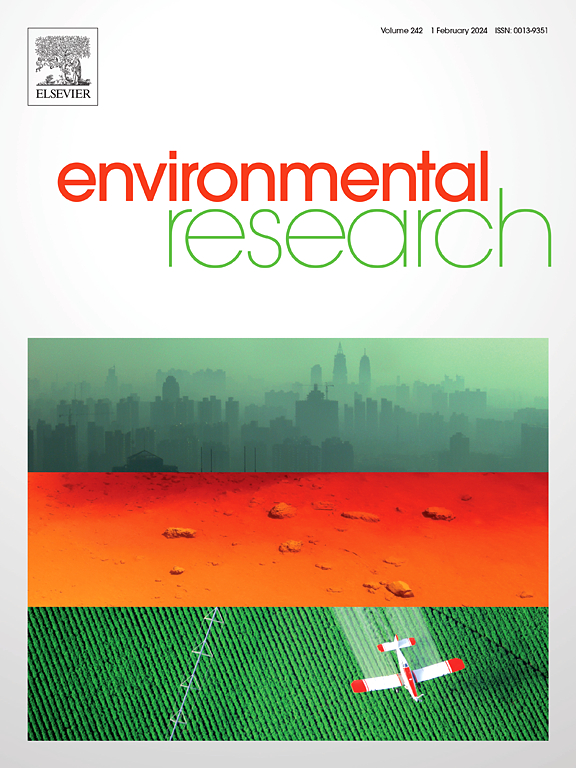Using the pollution load index to evaluate rooftop harvested rainwater metal(loid) contamination in environmental justice communities
IF 7.7
2区 环境科学与生态学
Q1 ENVIRONMENTAL SCIENCES
引用次数: 0
Abstract
Water scarcity poses a significant public health crisis exacerbated by climate change-induced disruptions to freshwater sources. Rainwater harvesting offers a sustainable solution by harnessing rooftop runoff for domestic use. This study analyzed 577 rooftop-harvested rainwater (RHRW) samples from four Arizona, USA environmental justice communities and 162 control samples from five National Atmospheric Deposition Program wet-only deposition collection sites across Arizona. The samples were tested for metal(loid)s, and the pollution load index (PLI) and Nemerow Integrated Pollution Index (NIPI) were used to assess contamination. The PLI was calculated for 11 known contaminants (As, Pb, Cd, Mn, Al, Cr, Cu, Zn, Ni, Ba, and Be), with the highest contamination factor observed for Ni (1340). PLI levels ranged from 0.118 to 65.8, with the active mining community Globe-Miami showing the highest range (0.244–65.8). The PLI was significantly greater during the monsoon season than during the winter season for all the communities (p < 0.05). Compared with urban communities (0.118–13.1), active mining communities (0.169–65.8) had higher PLI values. pH was positively correlated with PLI in Tucson (β = ln 0.27). In non-urban/rural mining communities, locations closer to potential contamination sources had higher PLI values (β = ln −0.33 to −0.38). However, in Tucson, the proximity relationship was less defined because of multiple potential contamination sources in urban areas. This study highlights the importance of using indices like PLI and NIPI to assess water quality; PLI reflects cumulative contamination burden, while NIPI contextualizes this burden within potential water uses. The strong positive correlation observed between PLI and NIPI across all use categories supports the validity of both indices and affirms utility. Together, they provide a nuanced understanding of pollution dynamics in RHRW and strengthen the case for public health interventions and ensuring the safety and sustainability of RHRW.

利用污染负荷指数评价环境正义社区屋顶雨水金属(loid)污染。
水资源短缺造成严重的公共卫生危机,气候变化对淡水资源造成的破坏加剧了这一危机。雨水收集通过利用屋顶径流供家庭使用,提供了一种可持续的解决方案。本研究分析了来自亚利桑那州四个美国环境正义社区的577个屋顶收集的雨水(RHRW)样本和来自亚利桑那州五个国家大气沉积计划纯湿沉积收集点的162个对照样本。采用污染负荷指数(PLI)和Nemerow综合污染指数(NIPI)进行污染评价。计算了11种已知污染物(As、Pb、Cd、Mn、Al、Cr、Cu、Zn、Ni、Ba和Be)的PLI,其中Ni的污染系数最高(1340)。PLI水平范围为0.118-65.8,活跃的采矿社区global - miami的范围最高(0.244-65.8)。各群落的PLI在季风季节显著大于冬季(p < 0.05)。与城市社区(0.118 ~ 13.1)相比,活跃矿区社区(0.169 ~ 65.8)的PLI值更高。图森市pH值与PLI呈正相关(β = ln 0.27)。在非城市/农村采矿社区,靠近潜在污染源的地点具有更高的PLI值(β = ln -0.33至-0.38)。然而,在图森,由于城市地区有多个潜在的污染源,邻近关系不太明确。本研究强调了使用PLI和NIPI等指数来评估水质的重要性;PLI反映了累积污染负担,而NIPI则将这种负担置于潜在用水的背景中。在所有使用类别中观察到的PLI和NIPI之间的强正相关支持了这两个指标的有效性,并肯定了效用。它们共同提供了对RHRW污染动态的细致理解,并加强了公共卫生干预措施和确保RHRW的安全性和可持续性的理由。
本文章由计算机程序翻译,如有差异,请以英文原文为准。
求助全文
约1分钟内获得全文
求助全文
来源期刊

Environmental Research
环境科学-公共卫生、环境卫生与职业卫生
CiteScore
12.60
自引率
8.40%
发文量
2480
审稿时长
4.7 months
期刊介绍:
The Environmental Research journal presents a broad range of interdisciplinary research, focused on addressing worldwide environmental concerns and featuring innovative findings. Our publication strives to explore relevant anthropogenic issues across various environmental sectors, showcasing practical applications in real-life settings.
 求助内容:
求助内容: 应助结果提醒方式:
应助结果提醒方式:


